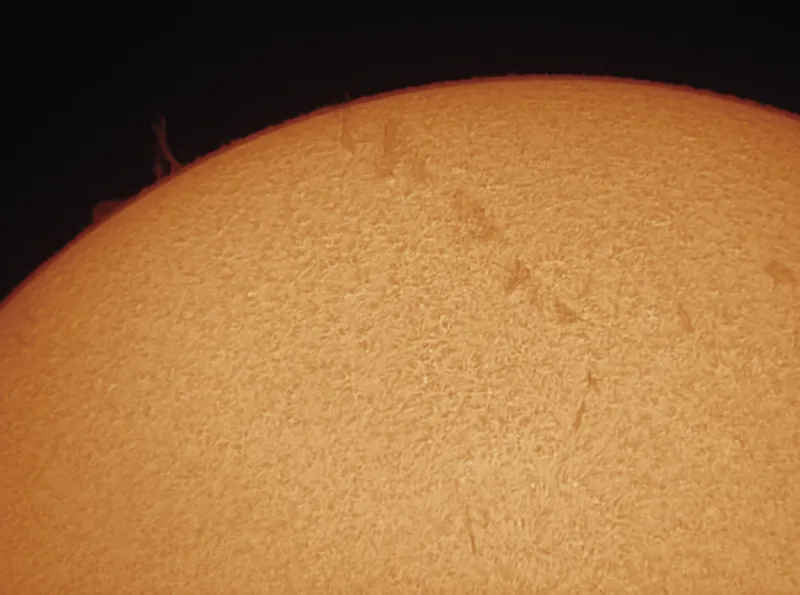The Coronado Personal Solar Telescope is instantly recognisable, due to its golden tube and solid-looking black-box body.
The front of the scope has a blue-coated 40mm objective lens.
It’s the job of this lens to converge sunlight towards the PST’s etalon assembly. This is located at the base of its tube, halfway along the scope’s focal length.
Temperature and pressure variations can alter etalon tuning slightly, and this can be compensated for with a tuning ring at the base of the objective tube.
A twist of the ring while looking at the Sun allows you to tune the etalon for the best possible view.
Focusing is done with a knob on the rear bottom-edge of the black-box body.
The body also contains a simple, yet very effective solar finder.
This telescope features in our list of the best solar telescopes.

To centre the Sun in the eyepiece’s view all you have to do is bring a tiny image of the Sun into the centre of a small circular screen close to the eyepiece.
A 1.25-inch eyepiece holder sticks out of the top of the body and this contains the PST’s 5mm blocking filter.
This component basically strips away the unwanted wavelength peaks that the etalon lets through, leaving only the one centred on H-alpha.
Sun seeker
The PST has a quoted bandpass of less than 1 Angstrom (Å), which is ideal for showing both prominences and surface detail.
During testing, the PST delivered a very acceptable view.
Prominences appeared bright, detailed and with good contrast against the background sky.
The edge of the Sun was also very detailed and had a distinctly fur-like appearance.
This is caused by the presence of spicules, short-lived plumes of glowing hydrogen gas 3,000-10,000km high.
Active regions and filaments were also well defined with lots of intricate detail.
Using our own 6.4mm Plössl eyepiece we had a detailed and comfortable view.
We found the supplied K20 20mm eyepiece adequate but not that comfortable to use, since it requires you to position your head quite carefully to see the full field of view.
Want to observe a solar eclipse? Find out when the next eclipse is taking place.

The PST produced some excellent results when used for imaging.
We couldn’t move the focuser inwards enough (called ‘in-focus’) to bring our planetary camera that was fitted with a standard nosepiece to prime focus.
However, screwing a 2x Barlow lens into the camera’s nosepiece worked fine.
All in all, this blueprint for budget H-alpha solar observing continues to deliver excellent low-, medium- and high-magnification views of the Sun.
And as it’s completely self-contained, it also makes a great grab-and-go scope.
Vital stats
- Price: £479
- Focal length: 400mm
- Aperture: 40mm
- Etalon: <1Å; 20mm unobstructed
- Finder: Built-in Sol Ranger
- Eyepieces: K20 (20x); 1.25-inch fit
- Weight: 1.4kg
- Supplier: Telescope House
- Tel 01342 837098
- www.telescopehouse.com
